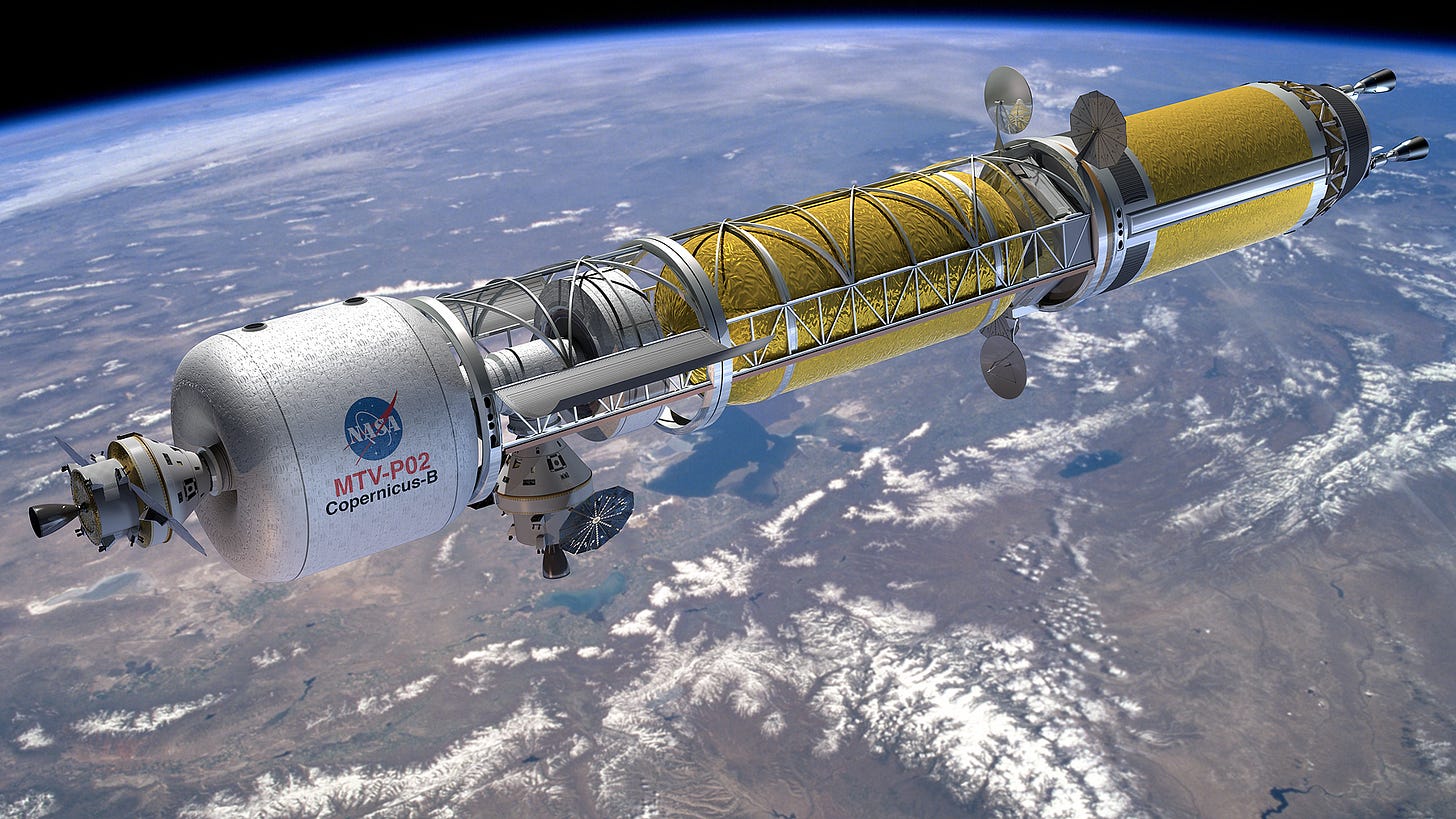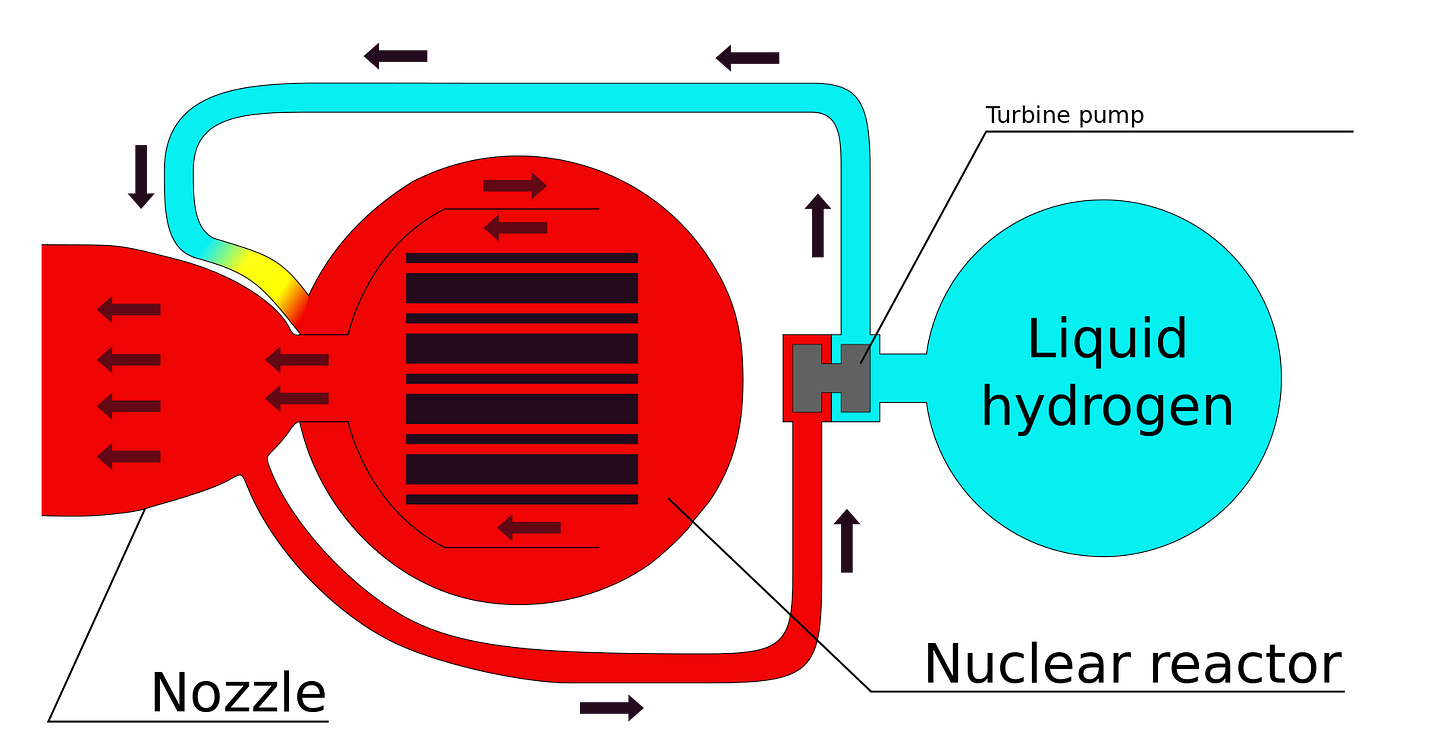Nuclear Thermal Propulsion
Revolutionizing Space Exploration
#We are making something exciting for space and astronomy fans, check here.
Introduction
Nuclear Thermal Propulsion (NTP) stands at the forefront of advanced propulsion systems, holding the promise of revolutionizing space exploration. By utilizing the immense energy potential of nuclear reactions, NTP offers the potential for increased thrust, higher specific impulse, and extended mission durations. This article delves into the intricacies of NTP, exploring its working principle, historical context, current research, and potential applications.
What is Nuclear Thermal Propulsion (NTP)?
The working principle of NTP is based on the nuclear fission process. In an NTP system, hydrogen flows through a reactor that is enriched with the fissile nucleus Uranium-235 in order to achieve fission. The heat generated by the fission process is used to heat the hydrogen to high temperatures, which then expands and is expelled through a nozzle to produce thrust. The fission process occurs because incident neutrons are “absorbed” in a fissile nucleus, and an excited state is produced. This excited state makes the nucleus very unstable, and if the compounded nucleus is excited enough, a fission of the nucleus occurs (or splitting). When this fission occurs, new product nuclei (such as Strontium-90 or Caesium-137) are created as well as gamma rays, an average of ~2.5 neutrons, and a release of total energy averaging ~190 MeV to ~200 MeV (depending on the fission fragments, delayed/prompt particles and their kinetic energies).
Brief history of NTP
The roots of NTP can be traced back to the mid-20th century when the United States and the Soviet Union embarked on ambitious nuclear rocket programs. In the United States, the Nuclear Engine for Rocket Vehicle Application (NERVA) project was initiated in the 1950s. NERVA successfully demonstrated the feasibility of NTP through extensive ground testing. Several engine designs were developed, including the NRX/XE, Pewee, and Phoebus. However, the NERVA program was eventually scaled back due to budget constraints and shifting national priorities.
Current Research and Development
Although NTP has not yet been utilized in operational missions, there is a resurgence of interest in the technology. NASA, in collaboration with other space agencies and private companies, is actively exploring the potential of NTP for future space missions. The Nuclear Thermal Propulsion Program, led by NASA, aims to design and develop a new generation of NTP systems for crewed missions to Mars and beyond. The program focuses on advancing reactor design, propellant technology, and safety measures.
Potential Applications of NTP

Deep Space Exploration: NTP holds great promise for deep space exploration missions, enabling faster transit times and increased payload capacities. The high specific impulse and thrust of NTP could significantly reduce travel times to destinations such as Mars, enabling more extensive scientific research and human presence in the solar system.
Lunar Missions: NTP could facilitate crewed lunar missions, allowing for increased payload capabilities and the establishment of sustainable lunar infrastructure. With its potential for efficient propulsion, NTP could support lunar base construction, resource utilization, and future human colonization efforts.
Interplanetary Missions: NTP could revolutionize interplanetary missions, enabling spacecraft to travel greater distances with enhanced efficiency. By reducing transit times, NTP could enable ambitious missions to outer planets, asteroids, and other celestial bodies within the solar system.
Cargo Transport: NTP systems could facilitate efficient cargo transport, allowing for the delivery of essential supplies, equipment, and resources to destinations such as the Moon or Mars. This capability would support the establishment and sustainability of long-term human presence in space.
Defense Applications: NTP also holds potential applications in defense. Nuclear-powered spacecraft could offer enhanced maneuverability and quicker response times for military operations, reconnaissance, and surveillance. However, the military applications of NTP raise concerns regarding arms control, safety, and environmental impact, necessitating careful consideration and international cooperation.
Conclusion
Nuclear Thermal Propulsion represents a groundbreaking advancement in propulsion technology, with the potential to revolutionize space exploration. By harnessing the energy released from nuclear reactions, NTP offers increased thrust, higher specific impulse, and extended mission durations. While still in the research and development stage, ongoing efforts by NASA, private companies, and international collaborations are paving the way for the realization of NTP's potential.
The development of NTP systems requires significant research and development efforts due to the complex nature of nuclear reactors and their associated safety concerns. One of the main challenges associated with NTP systems is developing materials that can withstand the high temperatures and radiation levels generated by nuclear reactors.
Despite these challenges, NTP remains one of the most promising technologies for space exploration due to its high specific impulse and potential for reducing travel times to other planets. With further advancements, NTP could enable humanity to explore the depths of space more efficiently and effectively, opening up new frontiers of discovery and understanding.




